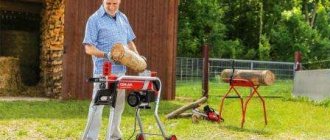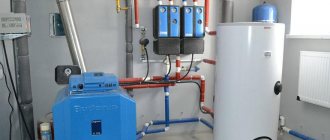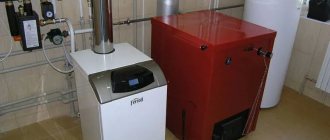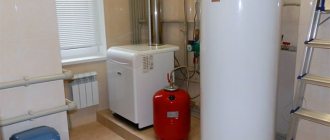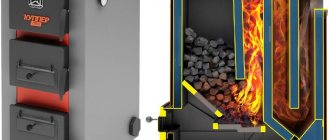Boiler DEFRO DUO, 25 kW
Technical and economic performance indicators of the DEFRO boiler by month of the heating period:
| Unit change | ||
| Heated area: | 200 | sq.m |
| Ceiling height: | 3,0 | m |
| Room temperature: | 22 | o C |
| Price of packaged coal: | 3,6 | rub./kg |
| Calorific value of coal: | 5,8 | kW*kg |
| DEFRO boiler efficiency: | 90 | % |
| Specific thermal characteristics of the building: | 0,41 |
Meaning
| Unit change | ||
| Fuel consumption for the heating season, t: | 8,32 | T. |
| Coal costs per season, rub.: | 29,935 | rub. |
| Average monthly coal costs, rub.: | 3,326 | rub. |
| Average boiler operating time on one fuel load, days: | 8,7 | days |
Calculation for the coldest day:
| Options: | Meaning | Unit change |
| Temperature of the coldest day of the year: | -39 | °C |
| Maximum heat consumption: | 15,84 | kWh |
| Maximum fuel consumption, kg/hour: | 3,00 | kg/hour |
| Approximate boiler power, kW: | 20 | kW |
As you can see, the estimated coal consumption will be 8.3 tons per season, and the average boiler operating time with 1 load of fuel is about 8.7 days. For climate zones 1 and 2, coal consumption will be noticeably lower; for climate zone 4, consumption will increase.
How to calculate coal consumption in a boiler for the heating season
How quickly is coal consumed in a solid fuel boiler? How much should you stock up on before the heating season so that the temperature in the house always remains comfortable? These and many similar questions are asked, perhaps, by every homeowner whose home is equipped with an individual heating system.
Let's try to figure out how to correctly calculate the coal consumption in the boiler, and what parameters need to be taken into account in order for the results to be accurate.
Why is it beneficial to use coal?
The operation of modern solid fuel boilers does not cause any trouble. Especially if the homeowner prefers coal - an efficient, safe, convenient and cost-effective fuel. Compared to other types of the latter, it has many advantages:
- is characterized by high heat transfer, allowing to obtain much more heat per unit of heated area;
- not afraid of humidity;
- does not require special sealed containers for storage;
- It is sold in a convenient package in which it can be easily transported to a city home or to the country.
Installing a coal boiler allows you to not depend on the presence of a gas pipeline within reach, which is especially important for residents of the private sector. In addition, this type of heating equipment can be installed without special permission, which cannot be done, for example, by purchasing a gas boiler.
An additional benefit of using coal as a fuel is provided by the special design of modern boilers. Over the years, not only the appearance of the equipment has improved, but also the method of burning fuel, and, accordingly, its consumption.
Firstly, there was no longer a need to pour coal into the firebox several times a day and clean out the slag. Modern boilers have large combustion chambers and special safe bunkers for storing fuel, from which it is automatically supplied to the firebox via a conveyor as needed. You can immediately load as much coal into the chamber as is necessary for continuous operation of the system for 10-12 hours, and the volume of the bunker is designed for 6-7 days of constant burning of the boiler.
The combustion chambers in modern models of heating equipment are completely sealed and equipped with special ventilation systems, thanks to which the strength of coal combustion and the degree of heating of the system are adjusted. Due to the forced supply of the optimal volume of air, the fuel burns out almost completely, leaving behind a minimal amount of waste, which allows to significantly reduce its consumption.
What factors need to be considered
When determining the consumption of coal in a boiler for heating a house, the most difficult thing is to select accurate initial data for performing the calculation. The volume of solid fuel required to heat a room depends on many parameters. First of all, you need to take into account the quality of the raw material: brown coal has the lowest heat transfer rates, and anthracite coal has the highest. You also need to consider:
- specifics of the heating system model;
- climate features (average daily temperatures in the cold season, duration of the winter period, etc.);
- materials that were used to build the house;
- the number of windows and doors, as well as what they are made of (wood or PVC);
- age and size of the house (number and area of rooms, ceiling height, number of floors, etc.);
- quality of thermal insulation materials;
- stoker's experience and skills.
At the same time, the listed factors must be considered as a whole. For example, when using the same boiler model, fuel consumption for heating a stone house after a major renovation and a country cottage without high-quality thermal insulation of the walls will differ dramatically.
It is almost impossible to take into account all variables when calculating, therefore, regardless of the type of fuel, only the average value of its consumption during the cold season is determined.
Regardless of the type of fuel, when calculating consumption, only the average value of its consumption during the cold season is determined.
Which coal is better
All types of coal suitable for use in heating systems have different characteristics and, most importantly, different heat transfer rates. It is also important to remember this when calculating the amount of solid fuel required to heat a room in the cold season.
In addition, the volume of by-products formed during combustion also depends on the type of coal. For example, varieties such as long-flame and gas coal emit large amounts of furnace gas and smoke when burned. This causes additional troubles for boiler owners during their operation: the equipment must be cleaned of carbon deposits more often, otherwise its service life may be significantly reduced.
The operating efficiency of a heating boiler directly depends on the quality of the raw materials loaded into the furnace. For example, when it comes to using firewood, the drier it is, the less it will be needed to heat the room. This rule works similarly for coal. Therefore, experts recommend using a premium product as fuel - anthracite “nut”, which has the highest heat capacity and burns completely in the firebox, leaving virtually no waste behind. Its cost is slightly higher than other types of coal, but it is consumed much more slowly, which means that much less of it will be needed before the end of the heating season. In addition, you can further save on delivery and equipment of a special room for storing large coal reserves.
Types of coal and its characteristics
When choosing, the type of coal plays an important role - its characteristics and scope of application depend on this.
Origin and basic properties of coal
Let's take a closer look at the key properties of coal.
Features of the origin of coal
Before talking about the characteristics, we should touch upon the topic of the origin of the fuel. In nature, most plants and animals begin to rot after death. The resulting mass serves as fuel for the growth of other plants and fungi.
However, certain factors can slow down the natural decomposition process. The mass that must rot accumulates in the soil. This is how peat appears.
Peat has been in the soil under enormous pressure for thousands of years, gradually moving deeper into the earth. Gradually it gets rid of water and foreign impurities, turning into brown coal. At greater depths it forms coal, and in the depths of the earth - anthracite.
The latter does not contain any third-party impurities. It is considered the cleanest coal and is therefore widely used in industry. However, mining anthracite is quite difficult.
Caloric value or calorific value
The mineral is used for heating because it releases a large amount of heat when burned. This is its main purpose. The amount of thermal energy that it releases during combustion is called “heat of combustion” or “calorific value”. It is expressed in calories.
The calorific value of coal is measured by the amount of heat released during the complete combustion of 1 kilogram of fuel. It should be borne in mind that pure minerals do not exist in nature. Coal contains foreign impurities, including water. As a result, part of the heat is spent not on heating, but on evaporation of moisture.
Therefore, the following calorie classification was introduced:
- Highest calorific value. This is a “dirty” indicator that shows the total amount of heat released during combustion. Includes both heating costs and evaporation costs.
- Net calorific value. Only takes into account heating costs. Essentially, this value shows how much heat the consumer will receive.
Ash content
The ash content of coal is an indicator of the percentage of ash content of the total mass of coal, which appears after complete combustion of the fuel. The characteristic shows the degree of mineralization, shows how many mineral impurities are in the coal. Ash content shows how clean the fuel is.
This indicator depends on the factors under which the coal was formed and at what depth it was discovered.
All mineral additives that are taken into account when calculating the ash content are divided into:
- Internal. They appear during the formation of fuel.
- External. These mineral additives appear in coal at the time of its extraction.
Ash content directly affects the amount of heat generated. The higher this indicator, the lower the thermal effect from combustion will be.
Humidity
During the formation of the corner, peat absorbs a large amount of moisture. Under high pressure, some of the water evaporates. But one way or another, any coal, even the purest anthracite, contains water. Its quantity is estimated when calculating the humidity index.
Surface humidity characterizes the indicator of water that remains on the surface of the coal. It evaporates easily after drying the mineral in direct sunlight. The remaining moisture characterizes the maximum moisture capacity. It depends on the type of coal and the conditions of its formation.
Humidity directly affects the quality of fuel. The higher this indicator, the more heat will be spent on water evaporation and, accordingly, less will be spent on heating. In addition, increased moisture affects the increased adhesion and freezing of coal.
Labeling and fractions
The marking indicates the type of fuel. The type of coal directly affects the calorific value, stickiness and other characteristics. One fuel is used in the energy sector, the other for heating homes.
The markings mainly use the letters “A” - anthracite, “D” - long-flame, “SS” - low-sintering.
Classification of hard coal:
| Coal grade | Designation | Volatile yield per combustible mass, % | Characteristics of non-volatile residue |
| Long flame | D | 36 or more | Powdery to slightly caked |
| Gas | G | 35 or more | baked |
| Gas fat | GJ | More than 31 (up to 37) | baked |
| Fatty | AND | 24-37 | baked |
| Coke fat | QoL | 25-33 | baked |
| Coke | TO | 17-33 | baked |
| Lean caking | OS | 14-27 | baked |
| Skinny | T | 9-17* | Powdery to slightly caked |
| Low-caking | SS | 17-37 | Same |
| *For Far Eastern coal grade T the value is 8-20% | |||
Coal fractions are the size of its pieces. This characteristic affects the combustion rate and fuel efficiency.
The following fractions are distinguished:
| Coal class | Designation | Piece size, mm |
| Plate | P | More than 100 |
| Large | TO | 50-100 |
| Nut | ABOUT | 25-50 |
| Small | M | 13-25 |
| seed | WITH | 6-13 |
| Shtyb | Sh | Less than 6 |
| Private | R | Up to 300 |
When marking, the type of coal and its fractions are indicated. For example, the abbreviation DM hides a long-flame mineral of a fine fraction. SSS is a low-caking coal of the shtyb fraction.
Brown coal
Brown coal belongs to the lowest category fuel. It is mined on the surface, so it contains a large amount of foreign impurities. It is used mainly in the domestic sphere - for heating houses.
Its maximum age is about 50,000,000 years. The color of this coal, as the name implies, is brownish. This is due to the fact that the mineral is formed from undecomposed wood.
It has not been refined to carbon. Carbon makes up only 50% of brown coal. The residue is foreign impurities that can be distinguished even on a cut. Because of this, the fuel is quite loose.
When burned, brown coal releases a small amount of heat. After it, a lot of ash remains and acrid smoke is released. Therefore, such fuel is not applicable in the energy sector - it does not burn without a residue. It is used if you need to heat your house as cheaply as possible.
Coal
Hard coal has superior characteristics to brown coal. It is mined at greater depths. The average age of the mineral is 400-200 million years. According to scientists, it appeared due to the decomposition of plants of the fern group.
Coal varies in color and texture. It is black or dark brown, and can be either matte or glossy. Usually has a fairly homogeneous dense structure. In appearance it partially resembles a small stone. With slight pressure, the coal begins to crumble.
Advantages of this variety:
- easier and better combustion;
- less smoke;
- greater amount of heat generated;
- less amount of foreign impurities.
Coal is used both in everyday life and in the energy industry. The only drawback of this variety is that it is difficult to light.
To buy coal in Yekaterinburg in bags, follow the link and be sure to look at the “Promotions” section.
Anthracite
Anthracite is a high-quality coal that is actively used in the energy industry. It is almost pure carbon without moisture or foreign impurities. It burns without residue and has a low ash content.
Anthracite looks very dense, with a glossy shine. Color - deep black or black with a small admixture of gray shades. It is more difficult to crumble; coal is very hard.
Advantages of anthracite:
- up to 99% carbon content;
- low amount of foreign mineral impurities;
- high heat of combustion;
- low humidity;
- combustion without smoke and flame;
- high electrical conductivity.
Anthracite generates a lot of heat, but it burns quickly. Due to its high cost, this type of coal is rarely used for domestic purposes.
How is the calculation carried out?
The design of modern boilers can significantly reduce coal consumption compared to earlier models. At the same time, the question of the amount of fuel required to heat a house still remains relevant, especially with the arrival of cold weather and before purchasing new heating equipment.
To get reliable results, you first need to decide on the initial data. Typically, average values are used for this:
- the duration of the heating season is 180 days (for example, from October 15 to April 15);
- living space size - 200 m²;
- the amount of heat required to heat 1 m² of room is 0.1 kW/h.
Accordingly, the length of a day is 24 hours, and the length of a month is 30 days.
There are 2 ways to estimate the volume of fuel consumption in the autumn-spring period:
- The easiest way is to calculate how many buckets of coal are needed to ensure a comfortable room temperature during the cold season. Owners of individual heating systems in September-October are limited to 1 bucket per day or 60 buckets in 2 months. From November to February they spend at least 600 buckets, and in the first months of spring they reduce the amount of fuel to 2 buckets per day or 120 buckets for the entire period.
This means that about 780 buckets of coal are needed for the season, while 1 bucket holds about 18 kg of raw materials. Multiplying these figures, we get a result of 14,040 kg or approximately 14 tons of fuel.
In addition, when making calculations, you can rely on average daily temperature indicators. For example, at 0 °C per day, heating a house usually requires 1 bucket of coal, and in severe frost (from -10 °C and below) - up to 10 buckets of fuel.
The calculation is based on the fact that for high-quality heating of a house with an area of 200 m² during the heating season, at least 50,000 kW of heat is required.
Combustion of 200 g of coal releases 1 kW of heat. Multiplying these data, we get 10,000 kg or 10 tons of fuel, which will be required to maintain the optimal temperature in the room during the cold season.
It should be remembered that under the influence of various external factors, the results of preliminary calculations most often turn out to be inaccurate. For this reason, the actual costs of coal during your first year of living in your own home can only be objectively calculated closer to summer and taken into account for the next heating season.
All types of coal suitable for use in heating systems have different characteristics
The optimal time of year for harvesting work
Procuring firewood for the winter is not just about cutting down a tree and cutting it into logs. It is necessary to ensure optimal storage conditions that ensure good drying of the wood. In addition, you need to know that the most optimal time of year to perform this work is the end of autumn and the beginning of winter. But the weather should not be rainy. The choice of this period is determined by the following factors:
- cutting down trees without leaves is easier;
- after the first frost, the logs are easier to split;
- in late autumn, the movement of sap stops, which makes it possible to obtain wood with a lower percentage of moisture.
All the forest cut down at this time of year is sawn into logs, chopped down, and the logs are sent for long drying until next autumn. You should not immediately throw them into the oven or boiler. From raw solid fuel you can only get a lot of soot, which will settle in the chimney as soot. For heating, logs from last year's harvest are used. They will give off maximum heat and minimum smoke. New firewood will be supplied next year
In order for the logs to dry well, it is important to provide good ventilation and protection from precipitation.
In the video you can see the process of collecting firewood:
When collecting firewood, it is not necessary to cut the forest yourself. After all, these logs will then have to be transported home. There are many companies providing this service. For really lazy people, hired workers can split logs into logs. In this case, your own labor costs will decrease, but the cost of solid fuel will increase.
fermilon.ru
How to reduce fuel costs
What to do to reduce coal consumption in a solid fuel boiler? The constant rise in fuel prices makes this issue relevant for most owners of individual heating systems.
To keep costs down and your home to remain warm and comfortable, you first need to pay attention to the quality of the room’s thermal insulation. Even small cracks in the walls of a house or unprofessionally installed windows significantly affect the temperature in the rooms, significantly increasing the amount of fuel required to heat them. Modern materials will help solve the problem, allowing you to insulate the house and retain heated air inside it for a long time.
The design features of the boiler also affect how much fuel is placed in one load.
Installing a thermostat is another effective way to reduce your coal consumption. With its help, you can save 10-15% of fuel - the automatic electronic system allows you to rationally use the boiler’s resources, reducing its operating power when there is no need for increased heating of the room.
Initial data for calculation
Calculation of solid fuel consumption per boiler during the season depends on many parameters: the area of the house and the height of the ceilings, the average temperature in the cold season, the duration of winter, the quality of the thermal insulation of the walls, the heat transfer of the fuel and the efficiency of the equipment.
It will not be possible to take into account all the variables, but we can calculate the average value for different types of fuel so that you can compare and choose the option that is right for you.
Let's take the following initial data:
- Let's take the duration of the cold season as 111 days, from November 27 to March 13.
- The area of the room is 100 square meters.
- The amount of heat to heat 1 square meter is 100 W per hour.
- Accordingly, there are 24 hours in a day and an average of 30 days in a month.
If necessary, you can substitute into the formula the actual area of the house, the duration of the cold season, depending on the region of residence.
Coal storage rules
Fuel should be stored in a dry, well-ventilated area where the temperature can be controlled. If the temperature exceeds 20 degrees, the mineral begins to oxidize. It cracks and becomes less dense. Oxidized coal burns poorly and is not suitable for heating.
The shelf life depends on the brand and fraction. For example, small anthracite can be stored for up to 36 months. Large - up to a year. After the expiration date, the fuel begins to deteriorate and oxidize.
It is important that water does not come into contact with the mineral. If coal is stored in an open area, it is necessary to cover it with a tarpaulin or build a waterproof shed. When water gets in, the fuel begins to pass oxygen better.
There should be no source of fire near the coal. It is prohibited to carry out any work involving heat or flame. Even welding is dangerous, as a spark can ignite the fuel.
Methodology for calculating the amount of fuel for the season
Let's figure out how to calculate the consumption of any type of fuel for a room. First, we will calculate how much heat is needed to heat the entire house per hour. Multiplying by 24, we get the daily value, then multiplying by 30 and 111 days, what is the consumption per month and for the entire heating period.
After this, we calculate the heat transfer of the accepted unit of measurement for each type of solid fuel. By dividing the amount of heat required per month and season by heat transfer, we will see how much of this type of combustible material is needed per month and for the whole year. This will show us how much fuel we need to store for the winter and allow us to compare the efficiency of different devices.
Best answers
Zhanna K:
my neighbor’s house is 6*6, that is, 36 square meters, made of timber, with an attic, he took 10 cubic meters last year, that is, Kamaz in bulk, barely enough for the winter, that is, 2 Kamaz trucks will probably be enough for you. The stove is also Butakova, it was always warm in the house.
Mikhalych:
it’s easy to calculate from the daily “norm” 80-120 liters per day passport request x for 30 x 8 months = 19 - 29 m3 WAREHOUSE (!) i.e. folded, not cubed from round timber...)))))
Anaida Zagoskina:
A lot depends on the stoves that heat your home. As a rule, such a room cannot be heated with one stove. If you have a baker and a stove, that is, two ovens, then 10 cubes will be enough. Heat the baker in the morning, and heat the stove or floods closer to lunch. The average temperature in the living space will be maintained constantly. If the bakery has a good chimney, then the additional stove can be heated in the evening.
Nikita:
I live in the north, a house of 90 square meters, 150x150 timber, a brick stove with a homemade water boiler, enough for 10 cubic meters (unsawn) for the whole winter + a bathhouse in winter 2 rubles a week, in summer every day. If you can do better with this crap, feel free to scrap it
Sergey Bogatyrev:
house 40 m 17 cubic meters but this is with a margin
Approximate calculation of solid fuel for a house with an area of 100 square meters
Firewood
To heat a house of 100 square meters, we need 100 square meters. m. * 100 W = 10 kilowatts of thermal energy per hour. Accordingly, per day it will be 10 kW/h * 24 hours = 240 kW. We will need 240 kW/day per month * 30 days = 7200 kilowatts, for the entire heating period 240 kW/day * 111 days = 26,640 kW.
Sometimes, calculations are based on the fact that the flame burns actively only 10 hours a day, which is enough to maintain the set temperature. Then the required amount of heat is 10 kW/h * 10 h = 100 kW. Often, based on this parameter, the consumption is written in the operating instructions.
On average, when burning 1 kg of oak wood, 3.4 kW is released. 240 / 3.4 = 70.6 kg of firewood will be burned per day, 7200 / 3.4 = 2117.64 kg per month, 26,640 / 3.4 = 7835.29 kg per winter. That is, in one winter, a solid fuel device burns almost 8 tons of wood.
It is also important to take into account that the calculation of consumption is also greatly influenced by the quality of the firewood, in particular its humidity, the type of wood it is made of, as well as the conditions of its storage. To heat such a house with firewood, a Zota 15a device is suitable.
Coal
One kilogram of coal emits 7.75 kilowatts when burned. Coal-fired equipment consumes 240 /7.75 = 31 kg of fuel per day. 7200 / 7.75 = 929 kg of coal will be required per month, for the entire heating season 26,640 / 7.75 = 3437.5 kg.
How much coal you will have to stock up and load at each load is greatly influenced by its type, ash content and the amount of foreign impurities. For heating this room with coal, the Teplodar Kupper OVK 10 solid fuel boiler model is suitable.
For industrial premises with an area of 5000 sq.m. m., a cast iron hot water boiler from Bratsk, running on coal with pieces of up to 100 mm in size, or Universal 5 and Universal 6 equipment are suitable.
Briquettes
A kilogram of briquettes, when burned, emits an average of 6.2 kilowatts. In one day 240 / 6.2 = 38.7 kg will be consumed, in a month 7200 / 6.2 = 1161 kg, in the winter season 4297 kg of briquettes. You can heat such a house with briquettes using the Peresvet T 10 device.
Void volume
What is the most common way to transport firewood? That's right, on old Russian-made trucks. And we know something about them. The body volume of the “53rd” “lawn” is 4.8 cubic meters. m. There is also a “collective farm” modification with high sides, then the volume increases almost 2 times. The volume of firewood in the body also depends on how it is stacked. But tell me, has anyone ever had neatly stacked firewood delivered to them?
They are almost always in bulk in the back. Well, accordingly, there is also a lot of empty space between the logs. However, there is nothing insurmountable for science in this ugly heap. because there is a special coefficient for converting the bulk volume into the volume of folded cubic meters. And it depends on the length of the log.
For example, for a 1/4 m log, the correction factor is 0.8. And for a log of 3/4 m - already 0.73. What does this wisdom mean for those who are not very good at mathematics? And the fact that 4 cubic meters of firewood with an average length of 25 cm, brought in bulk, after stacking will turn into 3.2 cubic meters.
How to save money on heating your home
Let's figure out how to reduce fuel consumption for heating your home. First of all, you should take care of high-quality thermal insulation of the room. By insulating your house in advance with modern materials, you will be able to consume less fuel by retaining heat, preventing the penetration of cold and taking longer to cool down.
This is also affected by the quality of the windows. It is advisable to call specialists who, using modern measuring equipment, can find particularly vulnerable spots in the house and insulate them.
In second place in terms of cost efficiency is the choice of modern solid fuel (SF) equipment. The pyrolysis apparatus and long-burning boiler have increased efficiency compared to classical models. The equipment configuration also determines how much fuel burns per load and how often you will have to add flammable materials.
The frequency of solid fuel loading varies greatly over time depending on the design of the apparatus. How much can be added at a time depends on the volume of the combustion chamber.
It is also effective to install a thermostat in the room. This will eliminate excessive boiler operation. An automatic electronic system will be the most efficient way to use boiler resources, saving an additional 10-15%.
Thermostat for heating system
Before choosing the type of fuel you are going to heat with, it is important to compare their prices and, multiplying by the required volume, calculate the most economical option.
Article rating:
Save to:
Coal consumption rate per 1 sq. m Link to main publication
